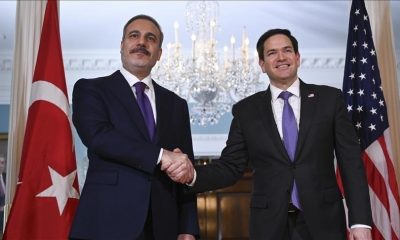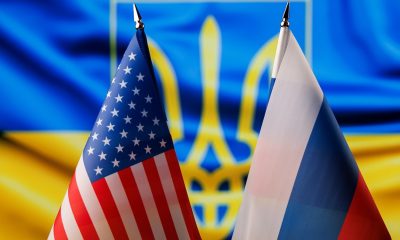DIPLOMACY
War in Ukraine revives global arms industry

Russia-Ukraine war continues to make global arms industry giants earn money, especially the U.S. and Europe. Strong arms companies, particularly in Europe, aim to increase their production capacity to be able to keep up with the orders.
The famous British company BAE Systems, for example, decided to restart the discontinued production of M777 howitzer, which had succeeded in the war. According to the BAE, Central European countries are interested in M777. The company’s vice president, Mark Signorelli, added that they need order of at least 150 new M777 to start production again.
U.S. military approval is expected to start reproduction. New orders are also coming in for American HIMARS and Anglo-Swedish co-made NLAW portable anti-tank missiles.
U.S. based usual suspects Raytheon Technologies, Lockheed Martin and L3Harris Technologies are also winners of the war. L3Harris received an order worth $200 million to be sent to Ukraine. Raytheon has started using obsolete parts from the old Stingers and has called his retired staff back into office to increase production. Lockheed Martin doubled the production of Javelin anti-tank missiles and increased the production of HIMARS rocket launchers and GMLRS missiles by 60 per cent.
The war ‘relieves’ German Industry
Struggling German industry due to the cutting of cheap Russian gas, has been given a consolation called war. Germany’s automotive and defence company and one of Europe’s leading arms manufacturers Rheinmetall AG, acquired the Spanish explosive manufacturing company Expal for 1.2 billion euros. Armin Papperger, CEO of the company, said the customers will sign contracts with companies who have the capacity. According to Rheinmetall, Expal expected sales of around 400 million euros in 2023.
Rheinmetall shares have gained 115 per cent since January 1st. The company announced that it has increased tank ammunition manufacturing from 70,000 to 140,000 in one year. Rheinmetall, which also increased its cannon production from 70,000 to 110,000, also doubled its mortar production capacity. Papperger noted that they increased their potential medium-calibre ball production capacity from 1.2 million to 2.2 million annually and increased their capacity to produce military trucks from 2,500 to 4,000.
Rohde & Schwarz, who developed German military communication equipment other than Rheinmetall, Traton of Volkswagen, who developed military vehicles together with Rheinmetall, and Krauss-Maffei Wegmann (KMW), the manufacturer of Leopard 2 tanks, are also struggling to fulfil orders.
The German government had recently ordered 100 Panzerhaubitze 2000 self-propelled howitzer to be sent to Ukraine. KMW will be responsible for their production. The contract is said to be worth 1.7 billion euros. These howitzers have recently become a hot topic in the German media, claiming that they are the subject of a complaint in Ukraine because of their maintenance.
KNDS, the joint venture between KMW and France’s Nexter says governments should shape new arms contracts. KNDS CEO Frank Haun underlines that they cannot risk increasing capacity with just speeches and announcements.
The German government’s rearmament programme is also an incentive for its struggling economy. Carl Jonasson, CEO of Snigel Design, a Swedish maker of military gear, did not hide the fact that he was surprised by the size of the order they received from Germany in May.
Eastern and Central Europe find new export markets
In addition to German armament manufacturers, the war industry of the former Warsaw Pact countries has also achieved a significant market with the Ukrainian war.
Sebastian Chwalek, CEO of PGZ, the state-owned weapons and ammo consortium in Poland, said they have an important opportunity to enter new markets and increase export revenues in the coming years. The PGZ consortium controls over 50 companies, from weapons to shipping.
PGZ plans to invest 1.75 billion euros in the next decade, Chwalek told Reuters. That’s more than double its pre-war investment plan. The new production facilities will be built away from the border with Russia’s ally Belarus for security reasons, he said.
In 2023, Chwalek announced that they had reached the capacity to produce 1000 pieces of Piorun MANPAD systems. This figure was 600 in 2022 and 300 to 350 in previous years. The company’s pre-war 2022 revenue target was 1.43 billion euros. With the new situation, it is thought that this income will be much higher at the end of the year.
Czechia is also one of the countries that put the arms industry at the service of war in Ukraine. Prague has sold 2 billion euros of weapons and equipment to Kyiv, Czech Deputy Defence Minister Tomas Kopecny told Reuters. Czechia (then Czechoslovakia), the largest weapons producer after the USSR during the socialist bloc period, has realized its highest arms export since 1989.
David Hac, chief executive of Czech STV Group, the largest ammunition producer in Czechia, said that they would create new production lines for small-calibre ammunition and that they were considering expanding its large-calibre capability. Considering the tight labour market, Hajj added, they are trying to get new workers from a slowing automotive industry.
Another Czech war giant, the Czechoslovak Group, nearly doubled its revenues in the first half of 2022 compared to the same period of the previous year. The Group’s spokesman, Andrej Cirtek, said their sales to the Ukrainian army multiplied after the war in Ukraine started.
Surprise attack from South Korea
South Korea, which has become the world’s fourth largest arms exporter, is also one of the winners of the Ukrainian war. The K2 tanks developed by ROTEM, an affiliate of the Hyundai-Kia Automotive Group, are already targeted by many countries from Mexico to Qatar.
Although Seoul has declared that it will not provide lethal aid to Ukraine directly, it is reported that the United States wants to buy ammunition from Korea to send to Ukraine. When details of the deal surfaced in the Wall Street Journal, the South Korean Defence Ministry insisted that they believed the U.S. was the ammunition’s end user.
Despite all these statements, South Korea’s relation with the Ukrainian war is not new. Last September, South Korea inked the largest arms agreement with Poland in its history to supply 1,000 K2 tanks, more than 600 Hanwha K9 self-propelled howitzers and dozens of combat aircraft to Warsaw. This deal will help Poland to send more weapons to Ukraine.
Customers of Hanwha K9 howitzers include Finland, India, Norway, Estonia, Australia, Egypt, and Turkey.
Limits of the arms industry
Under threat of deindustrialisation, the consolation that Europe found in war has its limits. The defence industry’s renaissance may begin to descend again due to the rising cost of materials and energy and dependence on imports from third countries.
Most of the raw materials needed to produce military products are not mined or are mined in limited amounts in EU countries, Jiří Hynek, head of the Association for Weapons and Defence Industry of the Czech Republic, told EURACTIV. Hynek underlined that most of the crucial materials are imported from Asian and African countries.
The materials that are in short supply on the market today are: all packaging materials, many chemicals but also the cellulose required for manufacturing gunpowder, and synthetic rubber, whose prices are astronomical, Hynek said. The latest material is used for ballistic resistant vests, and the EU is dependent on Asia, especially China, for this substance.
The price of steel has gone from 700 euros per tonne to 3500 euros, while aluminium has risen from 5 euros per kilo to 15 euros, according to Paolo Può, president of the Italian military shipbuilder Cantiere Navale Vittoria. Noting that most of their contracts are signed with the state, Può added that they are asking the government for intervention in the sector.
Rheinmetall also announced that they are stockpiling raw materials. The German arms manufacturer said that they purchased aluminium and important plastics in the first place, adding that they also obtained semiconductors to avoid supply problems in the medium term. The company also mentioned they have significantly increased working capital this year.
In France, on the other hand, the war industry has been experiencing production difficulties since before the Ukrainian war due to the semiconductor and chip problems.
DIPLOMACY
US proposes controversial ‘colonial’-style agreement to Ukraine
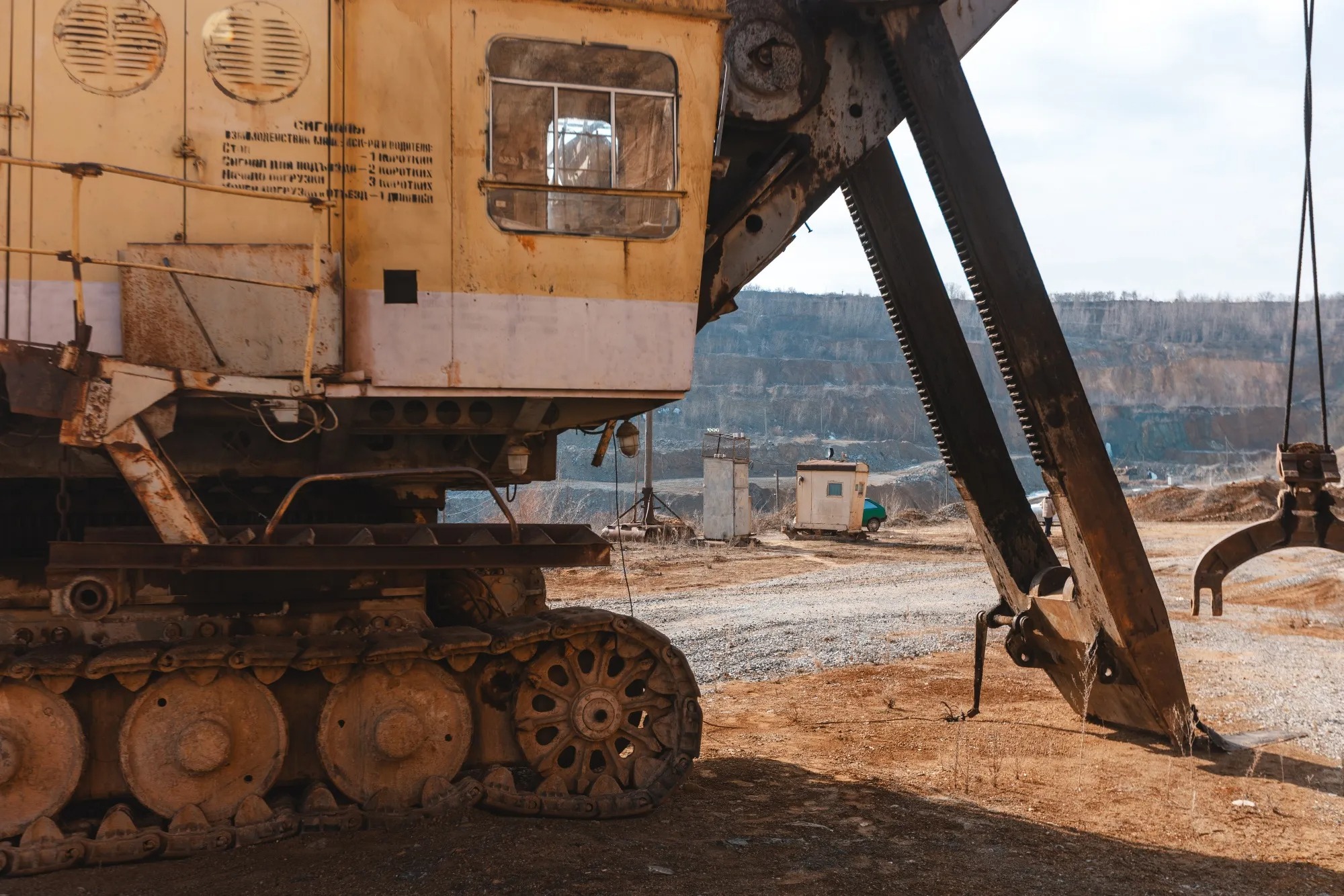
The US is pushing to control all future major infrastructure and mining investments in Ukraine, veto the role of Kyiv’s other allies, and undermine its goal of European Union membership.
According to a draft document obtained by Bloomberg, the Donald Trump administration is demanding the “right of first refusal” on investments in all infrastructure and natural resource projects under a revised partnership agreement with Ukraine.
If accepted, the partnership agreement would give the US enormous power to control investments in projects in Ukraine such as highways and railways, ports, mines, oil and natural gas, and the extraction of critical minerals.
The agreement would give the US first claim on profits transferred to a special reconstruction investment fund controlled by Washington.
The most crucial point of the document is that the US considers the “material and financial benefits” it has provided to Ukraine since the beginning of the war as a contribution to this fund.
In effect, this means the Trump administration would force Ukraine to pay the cost of all US military and economic support provided since the start of the war before Kyiv receives any income from the partnership fund.
According to the draft document, the US International Development Finance Corporation (DFC) will control the investment fund by nominating three of the five board members and holding a “golden share” giving it special voting rights to block certain decisions. Ukraine will appoint the other two members and will be prevented from interfering in the fund’s daily management.
The Kyiv government will be required to deposit 50% of the earnings from all new natural resource and infrastructure projects into the fund. The draft states that the US will be entitled to all profits until its investment is recouped, plus a 4% annual return.
Ukraine will be obliged to submit all projects to the fund for review “at the earliest possible time,” and the DFC will gain board membership or oversight rights in all funded programs.
Kyiv will also be prohibited from offering rejected projects to other parties on “materially better” terms for at least one year.
Furthermore, according to the draft, the US government will have the right to purchase Ukraine’s metals, minerals, and oil and gas on commercial terms before other parties, regardless of whether the fund finances the project.
The agreement, which has no time limit, also prohibits Kyiv from selling critical minerals to countries that are “strategic rivals” of the US.
The US presented a revised agreement to officials in Kyiv last weekend after Ukrainian President Volodymyr Zelenskyy’s plans to sign an earlier deal fell through following a tense discussion with Trump in the Oval Office last month.
The White House said last week that the administration has moved beyond the previously negotiated agreement covering critical minerals in Ukraine.
Negotiations between the two sides are ongoing, and the final draft may include revisions to the terms. A person familiar with the matter told Bloomberg that Ukraine would respond to the US document with its own changes this week.
Speaking to reporters in Paris on Thursday, where he traveled to attend a summit with European leaders, Zelenskyy said the full agreement proposed by the US requires “detailed study” and that the terms are constantly changing during negotiations.
While it is too early to say an agreement has been reached, he said, “We support cooperation with the US, we do not want to send a single signal that could cause the US to stop helping Ukraine.”
In response to a request for comment, a US Treasury Department spokesperson stated that the US remains committed to the swift finalization of the agreement and securing a lasting peace for Ukraine.
National Security Council spokesperson James Hewitt said, “The minerals agreement offers Ukraine the opportunity to establish a lasting economic relationship with the US, which is the foundation for long-term security and peace. This agreement will strengthen relations between the two countries and benefit both sides.”
Ukraine gained EU candidate status in 2022 and is set to begin accession talks for full membership, which could take years to complete. This situation is likely to become more complicated if the US gains effective control over investment decisions covering large areas of the Ukrainian economy.
Ukraine had previously stated that an agreement with the US should not conflict with its association agreement with the EU. It had also previously rejected the US demand that Washington’s past support for Ukraine be included as a contribution to the joint fund.
DIPLOMACY
EU to continue funding Türkiye despite İmamoğlu concerns, Politico reports
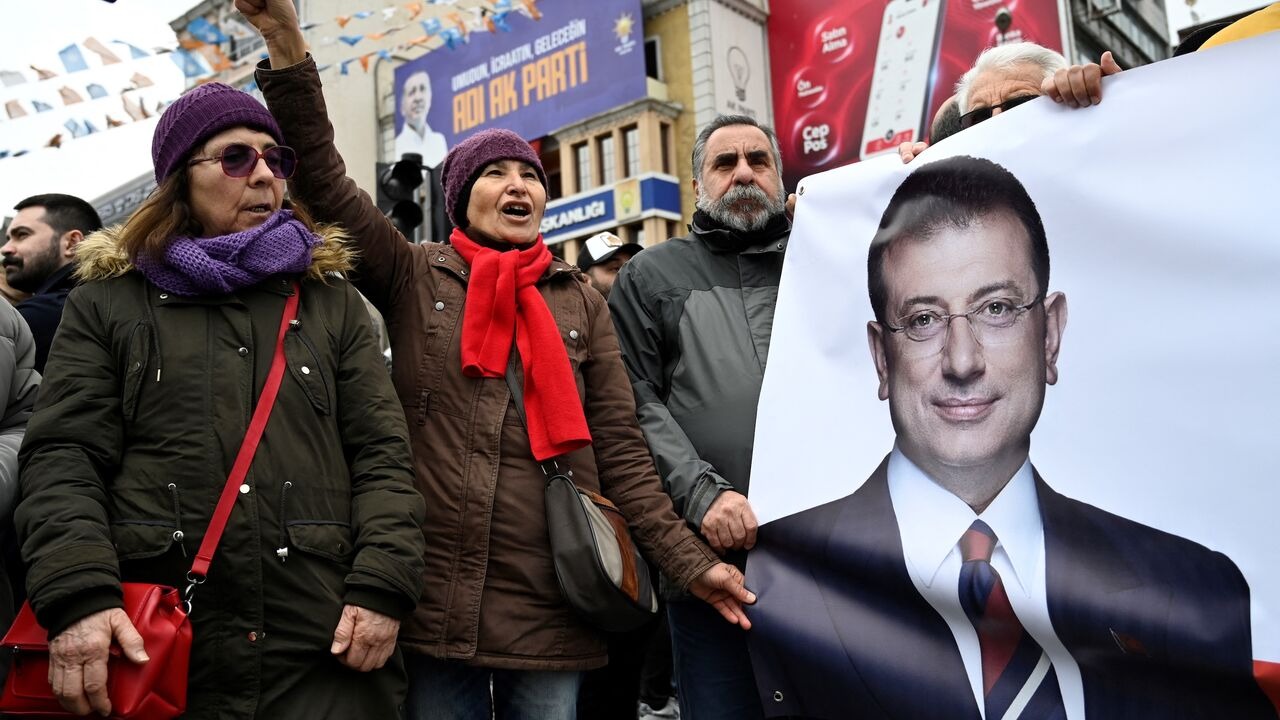
Protests following the detention and arrest of Istanbul Metropolitan Mayor Ekrem İmamoğlu seem to have put Europe in a difficult position.
In an assessment published in Politico titled “EU faces a billion-euro dilemma in Türkiye crisis,” politicians and officials cited say that regardless of what happens on the streets of Istanbul, Ankara is too important an ally to alienate.
The report states, “The European Union will continue to transfer billions of euros to Türkiye despite President Recep Tayyip Erdoğan’s extensive crackdowns on political opponents.”
Recalling that European officials warned their southern neighbor to “uphold democratic values” following Ekrem İmamoğlu’s arrest, Politico writes, “But Türkiye’s strategic importance means the bloc will likely look the other way. Erdoğan knows this too.”
Dimitar Bechev, a lecturer at Oxford University, says, “Whatever the Turkish leader does, the EU will have to follow suit.”
Two European officials, speaking to Politico on condition of anonymity, said that Türkiye’s EU candidate status requires it to protect democratic values and that Brussels would respond to violations. Although one of them stated, “We are following the developing situation in Türkiye with great concern” and “Recent developments contradict the logic of EU membership,” they also acknowledge that given Türkiye’s importance in migration, trade, energy, and defense matters, any reaction from the EU is unlikely to disrupt relations between Brussels and Ankara.
Pointing out that although Türkiye’s EU membership negotiations have stalled over the past decade, the country still receives billions of euros in accession funds, Politico notes, “Ankara has also received about 9 billion euros in aid to host refugees from the Middle East and is in line to receive large sums to support European defense industries.”
Highlighting that Türkiye, which has become a major hub for oil and gas exports, has a trade flow with the EU exceeding 200 billion euros annually, the publication writes, “Türkiye has also played a key role in controlling access to the Black Sea and enforcing sanctions against Moscow since Russia’s full-scale invasion of Ukraine in 2022. Recently, its potential significant contribution to a possible peacekeeping mission in Ukraine has been discussed.”
Bechev says, “The status quo before İmamoğlu’s arrest was comfortable for the EU because there was enough democracy,” and suggests that recent developments are not dire enough to change this.
According to the “Readiness 2030” plan presented by EU leaders last week, Türkiye, as an EU candidate country, has the potential to access 800 billion euros worth of joint procurements from funds designed to increase the bloc’s defense spending.
However, Greece and Cyprus, both long in conflict with Türkiye, are pushing for restrictions. Diplomats speaking to Politico said they intend to enact a clause requiring the defense move to occur “without prejudice to the specific character of the security and defense policy of certain Member States.”
Arguing that Athens and Nicosia, which were in the process of normalizing relations with Ankara before the recent crisis, now have to perform a “delicate balancing act,” Politico quotes a senior Greek official admitting that “even Athens cannot go too far.”
The Greek official involved says, “Of course, we will support a firm stance condemning the current developments in Türkiye, but without being provocative. The defense industry remains a major gap for Europe, which paves the way for this policy of trade-offs that we see happening.”
Even Cypriot MEP Michalis Hadjipantela, calling for “targeted sanctions” by stating “Effective pressure from the EU is essential,” also said that “sanctions should be targeted and linked to progress on the above issues to prevent further alienation of the country.”
DIPLOMACY
Fidan and Rubio discuss Syria, Gaza, and defense in US meeting
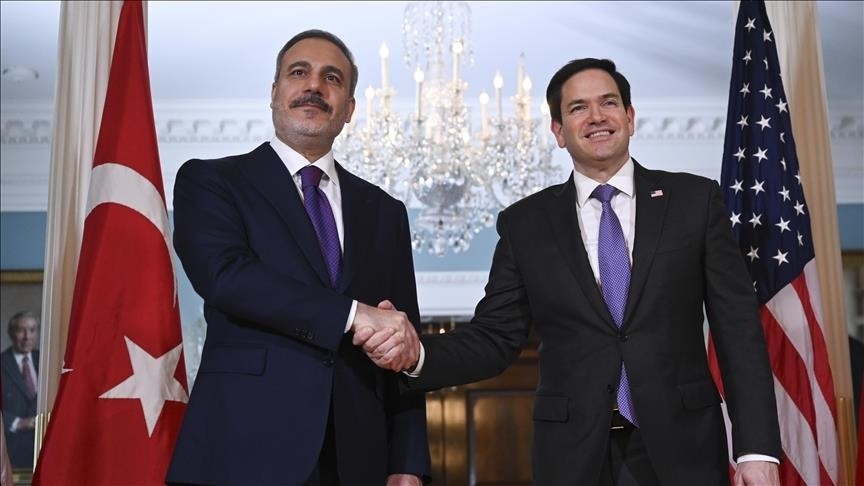
Minister of Foreign Affairs Hakan Fidan and his accompanying delegation began a two-day visit to the US.
During the visit, Fidan met with US Senator Marco Rubio. According to a statement attributed to US State Department Spokesperson Tammy Bruce, the two discussed cooperation on key issues in security and trade.
Rubio requested Turkey’s support for peace in Ukraine and the South Caucasus, while appreciating Ankara’s leadership in the “Global Coalition to Defeat ISIS.”
According to the spokesperson, the American senator reiterated the need for close cooperation to support a “stable, unified, and peaceful Syria,” stating they do not want Syria to be “either a base for international terrorism or a pathway for Iran’s destabilizing activities.”
Rubio also highlighted recent progress in bilateral trade and encouraged an even greater economic partnership moving forward.
Finally, the Senator expressed concerns regarding the recent arrest of Ekrem Imamoglu in Turkey and the subsequent protests.
Turkey has not made an official statement: AA reported based on ‘foreign ministry sources’
According to Turkish Foreign Ministry sources cited by AA, Fidan and Rubio emphasized the “importance of engaging with the Syrian government” during their meeting on Tuesday.
The sources stated, “Both sides emphasized the importance of engaging with the Syrian government and expressed their determination regarding the stabilization of Syria and the fight against terrorism.”
According to the sources speaking to AA, Fidan and Rubio discussed a range of regional and bilateral issues, including the need for a permanent ceasefire in Gaza, deemed essential for “regional peace.”
The sources also mentioned that the issues discussed in the phone call between President Recep Tayyip Erdogan and US President Donald Trump on March 16 were followed up on during the meeting.
The two sides also discussed preparations for upcoming presidential-level visits and expressed their determination to remove obstacles to defense cooperation.
The report added, “Both sides clearly expressed their political will to remove obstacles to cooperation in the defense industry. Technical meetings will be held to resolve existing issues.”
The two sides also discussed efforts to achieve a ceasefire between Russia and Ukraine, with Turkey expressing support for recent US efforts in this direction.
The talks also covered the ongoing peace process between Azerbaijan and Armenia and the importance of Bosnia and Herzegovina’s stability for the entire Balkan region.
Is Hamas on the table?
Meanwhile, Trump, during a White House meeting with a group of US Ambassadors confirmed by the Senate, referred to Turkey and Erdogan as a “good country, a good leader.”
The new US Ambassador to Ankara, Thomas Barack, was also present at the meeting. Barack, known as a close friend of Trump and a real estate magnate, thanked the President for appointing him to Turkey, “one of the ancient civilizations.”
In an article penned by Murat Yetkin in Yetkin Report, it is alleged that Trump might engage in bargaining over Hamas and Gaza in exchange for steps such as lifting CAATSA sanctions against Turkey.
Yetkin relays that CHP leader Ozgur Ozel, in a statement on March 18, referred to the Trump-Erdogan phone call, criticizing the lack of mention of Gaza and Israel, and accused Erdogan of “selling out the Palestinian cause for Trump.”
Recalling that Trump’s special representative Steve Witkoff told Tucker Carlson in an interview that they expect “good news” from Turkey, Yetkin underscores that Witkoff also stated elsewhere in the interview, “A terrorist organization cannot run Gaza; this is unacceptable for Israel. But their disarmament is possible. Then they can stay for a while longer and even get involved in politics.”
Yetkin asks, “Is Trump supporting Erdogan because of a plan to disarm the PKK and Hamas together?” while also noting that the Secretary of the PLO Executive Committee, Hussein al-Sheikh, met with Foreign Minister Fidan in Ankara on March 19, before Fidan flew to the US.
-
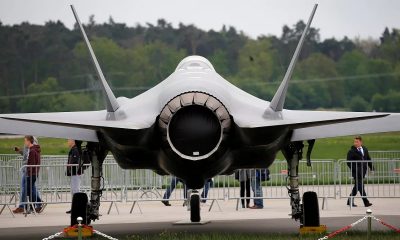
 EUROPE5 days ago
EUROPE5 days agoF-35 debate intensifies across Germany and Europe
-
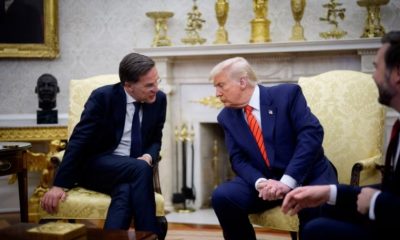
 EUROPE1 week ago
EUROPE1 week agoEurope plans for US absence in NATO with 5-10 year strategy
-

 ASIA2 weeks ago
ASIA2 weeks agoChina’s AsiaInfo expands with DeepSeek-powered AI
-
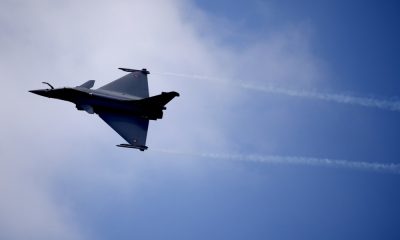
 EUROPE2 weeks ago
EUROPE2 weeks agoFrench defense industry gears up for war amid EU strategic autonomy push
-

 AMERICA2 weeks ago
AMERICA2 weeks agoTrump’s tariffs drive Nvidia to invest heavily in US manufacturing
-
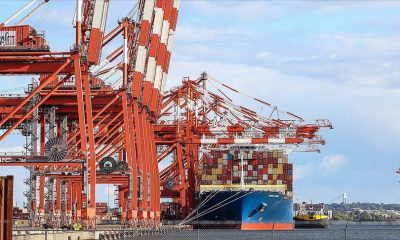
 DIPLOMACY6 days ago
DIPLOMACY6 days agoTrump’s proposed fees on Chinese ships threaten US maritime industry
-

 ASIA5 days ago
ASIA5 days agoBeijing’s energy rules threaten Nvidia H20 chip sales in China
-

 DIPLOMACY2 weeks ago
DIPLOMACY2 weeks agoUS, Britain, and Türkiye excluded from EU armament fund


